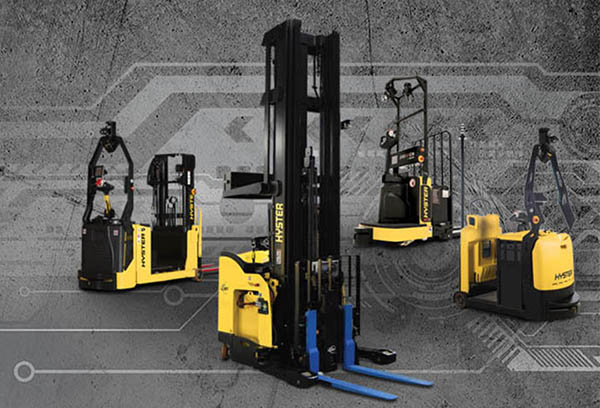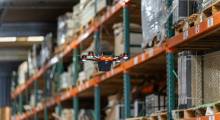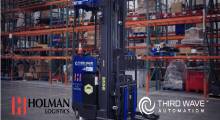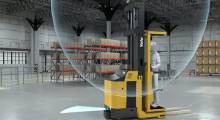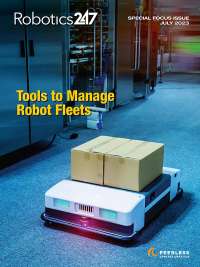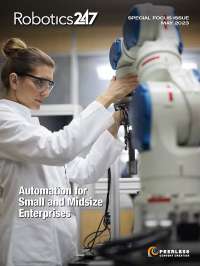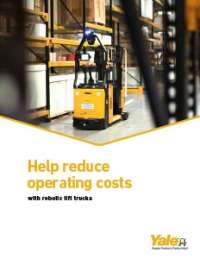Most of the major lift truck manufacturers are using technologies that can benefit both fully autonomous systems as well as help human operators be more effective. On balance, most lift truck technology advances today center on making operators more connected, comfortable, and productive. They include telematics and fleet software, operator assist and ergonomic features that use sensors, as well as motive power technology such as lithium-ion batteries that cut out battery-swap procedures.
“Much of our truck technology today is centered around making the trucks we have smarter and more intuitive, both for the operators and the managers,” said John Slavik, senior manager of intelligent warehouse solutions at Raymond Corp. “This would be, for instance, technologies like telematics or real-time locating features.”
“Just like our cars today, our customers want intelligence that provides more value than simply moving the vehicle from Point A to Point B,” he said. “I think our customers are starting to see their fleets as part of a greater system inside of their facilities. They want to understand the best ways for all these various pieces to fit together.”
Telematics offers increasing functionality
Telematics is perhaps the leading example of technology that helps operators as well as robots, noted Slavik. Features such as digital safety checklists can save time for operators, while fleet management software keeps track of use levels to ensure trucks are not under- or over-serviced, supporting uptime.
“These [telematics] systems are offering more and more functionality,” says Slavik. “I think just a few years ago, many companies were just starting to see the value [in telematics], but many weren’t quite ready. Now telematics is becoming more of a standard.”
Telematics’ main benefit comes from data-driven insights into fleet and operator performance. While the technology has been around for many years, users now see the value in the information beyond a way to record impacts or other incidents, or to digitize safety checklists and provide for access control.
“A lot of our customers are now using telematics to create policy,” said Slavik. “They understand the value of the data being generated and are restructuring the way they do things with their operators based on that data.”
Managers can use telematics to coach operators on safety-related concerns and reward top performers, and telematics and fleet software also provides insight on how the lift truck fleet itself is being used.
“It’s going to be giving utilization and performance insights both from the truck perspective and the operator perspective,” Slavik said. “You can use it to understand, for instance, whether we have the right truck for the job, based on the metrics. For example, if you have a reach truck with a lot of travel, the tasks that asset is doing might be better suited to a pallet jack.”
Details in the data
“If you marry the data up with warehouse management system [WMS] information, we can understand if a truck is being used efficiently to complete a certain task,” said Slavik. “Is an operator spending a lot of time on travel, without the appropriate amount of lifting? With telematics and fleet software, you can really dive into these details.”
Technology can help make operators more productive, according to Chad Munger, product manager for the Houston region at Mitsubishi Logisnext. “The focus for us is on features that will help the operators out, that will make their jobs easier, or more efficient, or even help newer operators perform like experienced operators,” he said.
Not only does telematics track impacts, incidents and service issues, but it can also provides for a wealth of data on how the assets are being used, said Munger.
“You are tracking travel time, lift time, impacts, operator presence, and key-on time, so it allows you to track a whole range of data that can be looked at from a high level to evaluate the performance and effectiveness of your fleet,” he said
Telematics has steadily gained more users over the years, while evolving in terms of additional operational analytics, said Bret Bruin, vice president of aftermarket operations at Toyota Material Handling.
“Telematics can help alter operator behavior for the better and improve overall safety, so it positively impacts both productivity and safety,” he said. “I think it took a while for people to understand the full range of benefits coming out of telematics. Now, I think we’re not too far away from telematics being an expected part of managing a lift truck operation.”
The granular, truck-specific data telematics and its related software sets the stage for OEMs to be able to support acquisition or leasing models based on usage, or “power by the hour,” added Bruin. While that’s not the standard acquisition model for lift trucks, Bruin said such data makes it possible for the industry to move in that direction.
Comfort = productivity
Ergonomic features—once more about seat or cab design rather than pure technology—now make use of sensors. Systems like semi-automated lift trucks can eliminate wasted movement with order-picking and operator-assist features. Today’s operator-assist functions can do things like automatically slow down trucks in high-risk areas, said Jim Hess, director of warehouse business development at Yale.
Operators can then more confidently focus on value-added tasks, since the machines will automatically adjust to minimize risks. Newer-generation trucks with object detection can also sense when other smart equipment is nearby, or the presence of people wearing proximity badges. Such technology can make an operator’s job easier, safer, and more productive, said Hess.
“We can set speed limits for these trucks in front of break rooms, or the door to the office area, so trucks are automatically slowed down,” he said. “Or, if there is an obstruction in the ceiling, maybe a heater or some pipes, the truck will not lift high enough to reach the danger height.”
“These functions protect your people, other trucks, inventory and other equipment like racking” Hess added. “They can help improve safety, and also productivity, because it gives the operators a high degree of confidence.”
Another advancement, Hess pointed out, is Yale’s “Operator Sensing System” on the floor of some of its newer models, which uses lasers to detect the presence of the operator. These optical sensors do away with the traditional “dead-man” pedals on the floor, allowing the operator freedom of movement.
Automation helps DCs face order deluge
The cumulative effect of such features is that operators are fresher, and distribution centers (DCs) are more productive.
“These DCs today are getting inundated with orders, and obviously, their focus needs to be on customer satisfaction and getting orders shipped on time and complete,” said Hess. “All of that requires an operator to be as fresh in the last hour of operation as they were in the first.”
Munger pointed out that semi-automated lift truck features can help with both ergonomics and productivity.
For example, certain Jungheinrich lift trucks offered by Mitsubishi Logisnext Americas have a semi-automated control feature called easyPILOT Follow that allow a truck to follow its operator automatically when the operator needs to stay on foot to pick orders. This capability saves time because the operator isn’t constantly on and off the truck, as the semi-automated functionality triggers the truck to advance and line itself up at the correct location.
“It’s almost as if the operator has an experienced partner along, driving the machine and lining it up exactly where needed,” sad Munger. “The upfront costs of a machine like that will be higher than your typical standard machine, but the result is it’s easier and more efficient for the operators to do their jobs.”
Electronics and sensors are increasingly used in features such as floor suspension systems that adjust at the touch of a lever to accommodate operators of different weights, he added.
“One of our top goals is to make operators more comfortable—to make their workday easier—through features like adjustable suspension,” Munger said.
Sensors enable control
Sensors have been used in lift trucks for years, but the industry is now benefitting from innovations. Toyota’s Bruin said the latest technologies can automatically slow or otherwise control trucks to create a safer environment.
“It’s not only about protecting the operator, but also any pedestrians or associates on foot, by leveraging automated obstacle detection and truck controls,” said Bruin.
Ergonomic features make an operator’s job easier and more comfortable, said Jared Ranly, marketing product manager at Crown Equipment. While some ergonomic features are more a matter of sound industrial design rather than technology, Ranly said the ergonomics of a lift truck are increasingly supported by sensors and integration with the lift truck controls.
“We recognize that operator comfort and confidence is critical to their job performance,” said Ranly. “If they’re not comfortable, if they’re not confident, they may not move as much product.”
Semi-automated systems, such as Crown’ QuickPick Remote order-picking technology, allow an operator doing order picking to a pallet to remotely advance the lift truck to the next pick location. Crown estimates this technology can save up to five seconds per pick and is another way technology helps get more done with less labor.
“At least in the States right now, the shortage of workers is driving customers to automated and semi-automated solutions,” said Ranly. “Many operations are struggling to find enough people, so they’re turning to automated solutions to be able to meet their customer service levels and get products shipped in a timely manner.”
While sensors are useful for tracking incidents as part of telematics, they're also helpful for avoiding incidents in the first place, observed Steven LaFevers, vice president of emerging technology at Hyster.
“The technology trend with our operator assist system is to add intelligence right into the truck, as an aid to help avoid pains like impacts, close pedestrian interactions and product damage,” he said. “Our latest, greatest systems can actually slow down the truck, providing operators with the additional reaction time needed to avoid hitting something, or even shut down a truck at pedestrian crosswalks or at the end of an aisle.”
Lithium rising
Motive power technologies on the rise include both lithium and hydrogen fuel cells because they offer high uptime without the time or DC space devoted to the battery swaps common to fleets that run on traditional lead-acid batteries, said Hess.
“There is an ROI for each of the technologies,” he said. “We have a whole organization that does power studies, that can study the application and the specific DC environment, and recommend the best power solution for a particular customer.”
Hess said that doing away with battery rooms can be an attractive benefit for space-crunched DCs.
“In today’s business environment, that’s very valuable space that can be freed up to increase the capacity and throughput of an operation,” he said. “That extra space can be used to improve storage density, or selectivity, or both, to help make the operation more effective.”
For busy, multi-shift operations using two or three lead-acid batteries per truck per day, lithium-ion is worth a closer look, said Crown’s Ranly.
“The chemistry for lithium-ion batteries is constantly getting better,” he said. “It’s no secret that it costs more than lead-acid, but companies need to look at the overall return on investment with lithium-ion for their application needs. We can help them assess the ROI and see if a lithium-ion solution will make sense for them.”
However, when deploying lithium-ion, it’s important to carefully lay out the opportunity charging points and educate operators on the importance of recharging.
“The secret to success with lithium-ion is that the batteries need to be opportunity charged during breaks and lunches,” said Ranly. “Anytime the truck is not in use for more than 10 minutes, it should be plugged in.”
Hydrogen fuel cells and thin-plate, pure lead (TPPL) technologies are other options for companies looking to do away with battery swaps. LaFevers noted that lithium is growing in popularity, but that hydrogen fuel cell technology is another option to consider for busy, multi-shift operations.
The beauty of hydrogen is that trucks can be refueled in about three minutes, whereas lithium will typically require more frequent opportunity charging, he said. In addition to the rapid recharge, lithium may appeal to corporations with sustainability initiatives, explained LaFevers.
“Lithium is awesome, with its opportunity charging, no watering of the battery, no equalization needed, and other benefits, but I just think that for the very high-velocity operations with high demands around uptime and productivity, users should have a clear understanding of the full benefits of hydrogen,” said LaFevers.
Toyota liked the characteristics of TPPL so much, according to Bruin, that it chose TPPL as the motive power for the lift trucks it uses at its parts DC in Indiana.
“We’ve been extremely pleased with that choice,” he said. “It has a lot of same benefits that lithium does, in terms of opportunity and fast-charging, and being virtually maintenance free with no watering, battery cleaning or changing required.”
“It may not be right for the really high-throughput applications, but I think it has its sweet spot for many light- to medium-duty operations,” Bruin added. “Just like with lithium, it’s a matter of assessing the application benefits and costs, and making the ROI work.”
In many ways, lift truck OEMs are taking a dual path to addressing labor availability concerns. One is the fully automated lift truck. In addition, a range of other technologies, including new motive power options, operator-assist functions, and semi-autonomous functions, can maximize the productivity of human operators. Ultimately, these systems can help front-line workers rather than replace them.
About the Author
Follow Robotics 24/7 on Linkedin
Article topics
Email Sign Up

